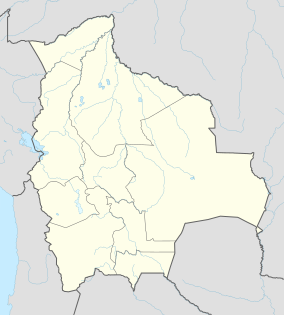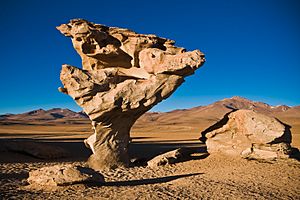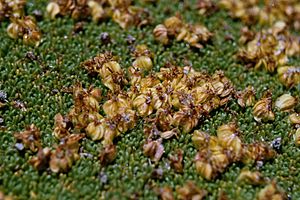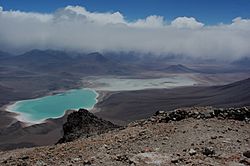Eduardo Avaroa Andean Fauna National Reserve facts for kids
Quick facts for kids Eduardo Avaroa Andean Fauna National Reserve |
|
|---|---|
|
IUCN Category IV (Habitat/Species Management Area)
|
|
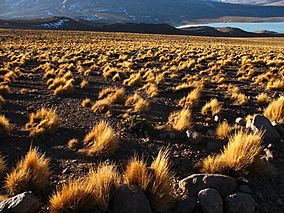
Stipa ichu in the reserve.
|
|
| Location | Potosí Department, Sur Lípez Province |
| Area | 7147.45 km² |
| Established | 1973 |
| Visitors | 67,000 (in 2007) |
| Governing body | Servicio Nacional de Áreas Protegidas (SERNAP) |
The Eduardo Avaroa Andean Fauna National Reserve (also called REA) is a special protected area in Bolivia. You can find it in the far southwestern part of the country, in Sur Lípez Province. It's the most visited protected area in Bolivia, especially popular in the Potosí Department.
This reserve sits very high up, between 4,200 and 5,400 meters (about 13,780 to 17,720 feet) above sea level. It covers a huge area of 714,745 hectares (over 1.7 million acres). The reserve is mainly set up to protect the many birds that live in its lagoons. It also helps protect a part of the Central Andean dry puna, which is a unique type of high-altitude grassland. The best parts of the reserve are its active volcanoes, bubbling hot springs, geysers, and beautiful lakes. It's also famous for its three types of flamingos that live there.
Contents
History of the Reserve
The Eduardo Avaroa Reserve was created in 1973. It's named after Eduardo Avaroa, a Bolivian war hero from the 1800s. The reserve was made official by a special government order in December 1973 and later made even bigger in May 1981. Since 2009, the entire reserve has been part of a larger area called the Los Lípez Ramsar site, which means it's recognized as an important wetland internationally.
Exploring the Geography
The reserve is located in the southern part of the Andean mountains in southwestern Bolivia. The mountains here are very tall, ranging from 3,500 to 5,000 meters (about 11,500 to 16,400 feet) high. The area has many interesting features like active volcanoes, hot springs, and geysers. Some people even compare it to Yellowstone National Park in the US!
Water is scarce here because there's very little rain, only about 76 millimeters (3 inches) each year. So, the water sources are mostly lakes and salty lagoons. Two small communities, Quetena Chico and Quetena Grande, are located inside the reserve.
Amazing Lakes
The reserve is home to several stunning lakes:
- Laguna Verde (Green Lagoon)
- Laguna Colorada (Red Lagoon)
- Laguna Salada (Salty Lagoon)
- Laguna Busch
- Laguna Hedionda (Stinky Lagoon)
Laguna Colorada is especially famous. It sits at 4,278 meters (about 14,035 feet) high and covers 60 square kilometers (about 23 square miles). It gets its red color from tiny living things in the water, which change color with the wind and sun. This lake is very shallow, less than 1 meter (3 feet) deep. It's a home for about 40 bird species, including rare James's flamingos. These flamingos eat the pink algae in the lake and can even walk across it because it's so shallow!
The Stone Tree
One of the most photographed natural wonders in the reserve is the Árbol de Piedra. This unusual rock formation looks like a stunted tree sticking out of the sand dunes in the Siloli Desert. It's about 18 kilometers (11 miles) north of Laguna Colorada. Strong winds have shaped this thin rock over time, making it look just like a tree made of stone.
Climate
The weather in the reserve can be quite harsh. Winters (May to August) are dry with no rain. Summers (December to April) also have very little rain. The average temperature is about 3 degrees Celsius (37 degrees Fahrenheit). The coldest months are May, June, and July.
Mountains in the Reserve
The reserve is surrounded by many tall mountains. Some of the notable ones include:
- Sairecabur – 5,971 m (on the border with Chile)
- Putana – 5,890 m
- Licancabur – 5,920 m (on the border with Chile)
- Juriques – 5,704 m (on the border with Chile)
- Zapaleri – 5,090 m (on the border with Argentina and Chile)
- Linzor – 5,680 m
- Michina – 5,537 m
- Nelly – 5,078 m
Local Culture
Two small communities, Quetena Chico and Quetena Grande, live within the reserve. Quetena Chico was founded in the 1920s and has about 520 people. Quetena Grande is smaller, with about 180 people. Most of the people here are of Quechua descent, but their main language is Spanish. For a long time, they didn't have healthcare or schools. Electricity and clean water were also not available until recently.
Near Quetena Chico, you can find old archaeological sites. These include stone huts called jaranas, trail markers called tambos, rock paintings, and a special ceremonial site between two volcanoes. There's also an archaeological site called Atulcha (or Chullpares) with mummies in a cave on Tunupa Volcano.
Economy and Jobs
For the local communities, raising camelids like llamas has been a very important way to earn money. They sell llama wool and meat. However, since the reserve was created, hunting foxes (which prey on llamas) has been restricted. This has made it harder for people to protect their llamas. Before the reserve, locals also used to sell flamingo eggs.
Tourism is growing fast in the reserve. In 2007, over 67,000 people visited, which was six times more than in 1997! The park's visitor center is in Quetena Chico, and many locals now work in the tourism industry. Some also look for gold in the Río Quetena.
Mining is another big industry in and around the reserve. The area is rich in natural resources like lead, zinc, and silver. There are 61 mining areas within the park. Non-metal minerals like sulfur and ulexite are also extracted. Ulexite is used to make boric acid and is sent to countries like the United States, Europe, Asia, and Australia.
Plants of the Reserve (Flora)
The reserve's high Andean environment has unique plants, mostly tropical alpine herbs and small shrubs from Polylepis forests. There are about 190 different plant and tree species here. These plants have adapted to tough conditions like salty soil, little fresh water, cold temperatures, and few nutrients. Some plants, like Barneoudia, Hexaptera, Nototriche, Pycnophyllum, and Werneria, are found only in this region.
A common plant is pasture grass, like Peruvian feather grass (Stipa ichu), found on plains and hillsides. A very important plant for locals is yareta. It grows very slowly, only 1-3 millimeters (0.04-0.12 inches) per year, in rocky areas. This plant looks like foamy bubbles but is as hard as stone. It can grow up to 1.5 meters (5 feet) tall and 3 meters (10 feet) around, and some yareta plants can be as old as 3,000 years! Locals use it as firewood. In wetter areas, you can find Tola (Parastrephia lepidophylla), Quinoa, and Kenua bush trees. Villagers use these plants for heating and cooking.
Animals of the Reserve (Fauna)
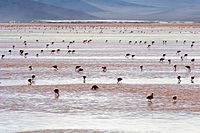
The reserve is home to many animals that have adapted to the extreme conditions. Some of these animals are endangered.
Birds
About 80 species of birds live here. Out of the six flamingo species in the world, three are found in large numbers in the reserve's lakes and lagoons:
- Chilean flamingo (Phoenicopterus chilensis)
- Andean flamingo (Phoenicoparrus andinus)
- James's flamingo (Phoenicoparrus jamesi)
In 1994, there were about 26,600 flamingos counted in the reserve! Other birds you might see include falcons, ducks, lesser rhea (Pterocnemia pennata), puna tinamou ((Tinamotis pentlandii)), and Andean goose ((Chloephaga melanoptera)). Some rare birds found here are the endangered Ash-breasted tit-tyrant and the critically threatened royal cinclodes.
Mammals
There are 23 types of mammals in the reserve. These include pumas, Andean foxes, and vizcachas (which look like rabbits). You can also find endangered animals like vicuñas (Vicugna vicugna), suri, Andean condor, and the Andean cat (Felis jacobita).
Challenges and Threats
The Polylepis forests in this region have been badly damaged. Too much use of Polylepis tarapacana and Azorella compacta (yareta) has put a lot of stress on the reserve. This happens because of:
- Animals grazing too much on native plants.
- People cutting down trees for fuel.
- Burning land for farming.
- Waste from mining being dumped.
Tourism, while good for the economy, is also a threat. Many visitors come each year, and there aren't enough park guards to manage the impact. Human activity, soil erosion, and pollution in the lakes and lagoons also harm the flamingos.
Protecting the Reserve (Conservation)
The Bolivian National Protected Areas Service (SERNAP) is in charge of running and taking care of the reserve. They have 14 trained park guards with vehicles and radios. Because more and more tourists visit, SERNAP has created a special plan. This plan includes ecotourism (tourism that helps the environment) to earn money for the reserve. In 2006, entrance fees brought in about $200,000! This means they need to study how many tourists the reserve can handle without being harmed.
SERNAP works with TROPICO, a non-profit group that helps protect nature in Bolivia. Together, they make sure environmental rules are followed in the reserve. A program called Parks in Peril (PiP) also helped fund conservation work between 1999 and 2002. This program helped the reserve use its entrance fees to pay for conservation efforts. This successful idea is now used in other parks in Bolivia.
Other ways they protect the reserve include:
- Limiting where visitors can go to protect sensitive areas.
- Providing natural gas and solar energy for cooking, so people don't cut down trees for firewood.
- Teaching farmers better ways to farm.
- Improving facilities and adding more staff for patrolling and security.
- Collecting scientific information to help manage the park.
See also
 In Spanish: Reserva nacional de fauna andina Eduardo Abaroa para niños
In Spanish: Reserva nacional de fauna andina Eduardo Abaroa para niños
- Salvador Dalí Desert
- Sol de Mañana
- Laguna Blanca
- Salar de Chalviri
- Portezuelo del Cajón
Images for kids


